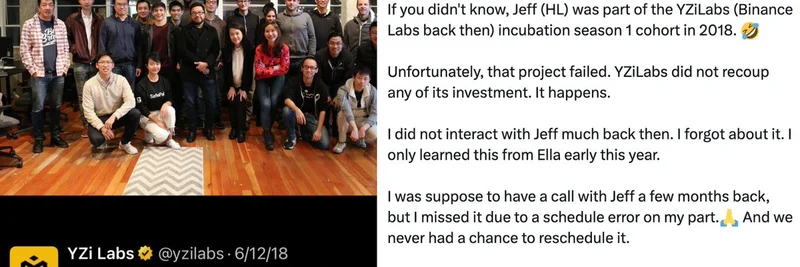In the wild world of crypto, where fortunes flip faster than a meme token pump, stories of perseverance hit different. Recently, Changpeng Zhao—CZ, the iconic founder of Binance—shared a juicy tidbit on X about Jeff Yan, the brains behind Hyperliquid. It's a classic tale of stumbling early only to sprint ahead later, and it's got the community talking about resilience in blockchain building.
CZ's Gossip Tweet Breaks It Down
CZ posted what he called a "gossip tweet," spilling the beans on Jeff Yan's early days. Back in 2018, Jeff (often referred to as HL in crypto circles) was part of the first incubation cohort at what was then Binance Labs—now rebranded as YZi Labs. The project? It didn't pan out. CZ admitted that YZi Labs didn't recoup any investment, shrugging it off with a simple "It happens."
He mentioned not interacting much with Jeff back then and even missing a scheduled call due to a mix-up on his end. Fast forward to today, and CZ's tone is all support: "Regardless, we support all builders!" This nod comes amid Hyperliquid's massive success, proving that one flop doesn't define a founder.
Who Is Jeff Yan and What's Hyperliquid All About?
If you're new to the scene, Jeff Yan isn't your average crypto dev. With a background in high-frequency trading at firms like Hudson River Trading, he brings serious tech chops to the table. His 2018 venture was reportedly a prediction market platform that fizzled out between 2018 and 2022. But Jeff didn't quit—he pivoted hard.
Enter Hyperliquid, a decentralized perpetual futures exchange (think trading contracts that never expire) built on its own Layer-1 blockchain. What sets it apart? No venture capital, no presales, just pure bootstrapping with a tiny team of about 11 people. Today, Hyperliquid boasts a token valuation around $16 billion, with its native token HYPE ranking high in the crypto charts. It's often compared to a "decentralized Binance" for its speed and user focus, outpacing centralized giants in the perps game.
In interviews, like his chat with Wu Blockchain, Jeff emphasizes building for users over hype. He turned down VCs to keep things fair and focused, a move that's paid off big time.
Why This Matters for Meme Token Creators
At Meme Insider, we're all about the chaotic energy of meme tokens—those viral, community-driven coins that can moon or rug in a heartbeat. Jeff's story resonates here because meme land is littered with failures. One bad launch? Dust yourself off and try again. Just like Jeff pivoted from a failed prediction market to a top-tier DEX, meme devs often iterate on ideas until they stick.
Think about it: Hyperliquid's HYPE token has that meme-like buzz, fueled by organic growth and community vibes rather than big-money backing. It's a reminder that in blockchain, persistence trumps perfection. CZ's shoutout underscores the industry's supportive side— even big players like YZi Labs, which just announced a $1 billion fund for BNB Chain projects, cheer on builders regardless of past flops.
Lessons from the Crypto Trenches
This revelation isn't just gossip; it's gold for anyone grinding in Web3. Key takeaways:
Failure is Fuel: Jeff's 2018 setback was "tuition for the game," as one X user put it. In crypto, especially with meme tokens, quick pivots can lead to massive wins.
Bootstrap for the Win: Skipping VCs kept Hyperliquid aligned with users, avoiding the pitfalls of overhyping or unfair token distributions—lessons meme projects could use to avoid rugs.
Community Over Everything: CZ's support echoes the builder ethos in crypto Twitter, where degens and devs alike root for comebacks.
As the space evolves, stories like this keep the fire alive. Whether you're trading HYPE, launching your own meme coin, or just watching from the sidelines, remember: today's failure could be tomorrow's unicorn. Stay tuned to Meme Insider for more insights into the meme token ecosystem and beyond. What's your take on Jeff's journey? Drop it in the comments!


